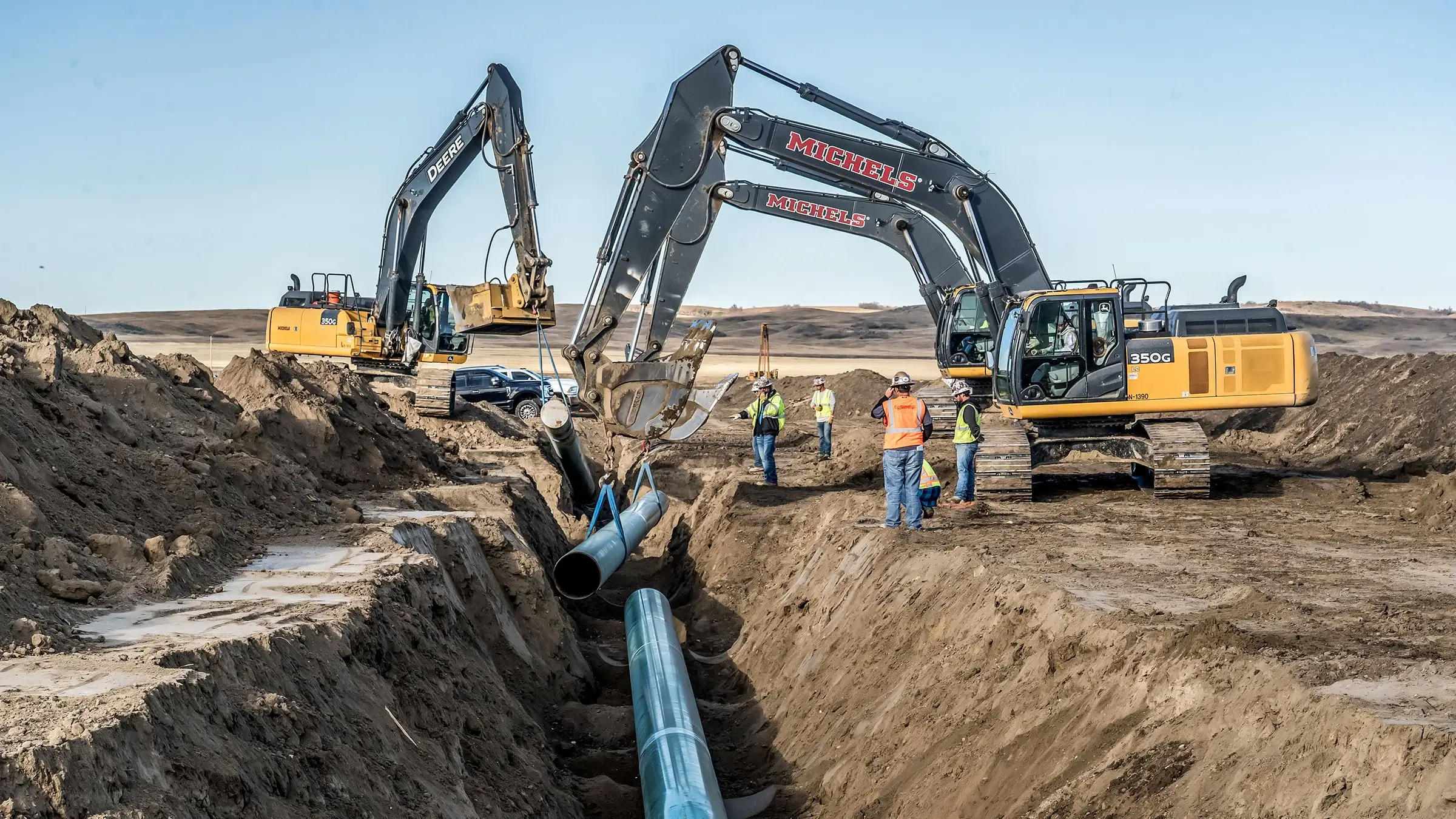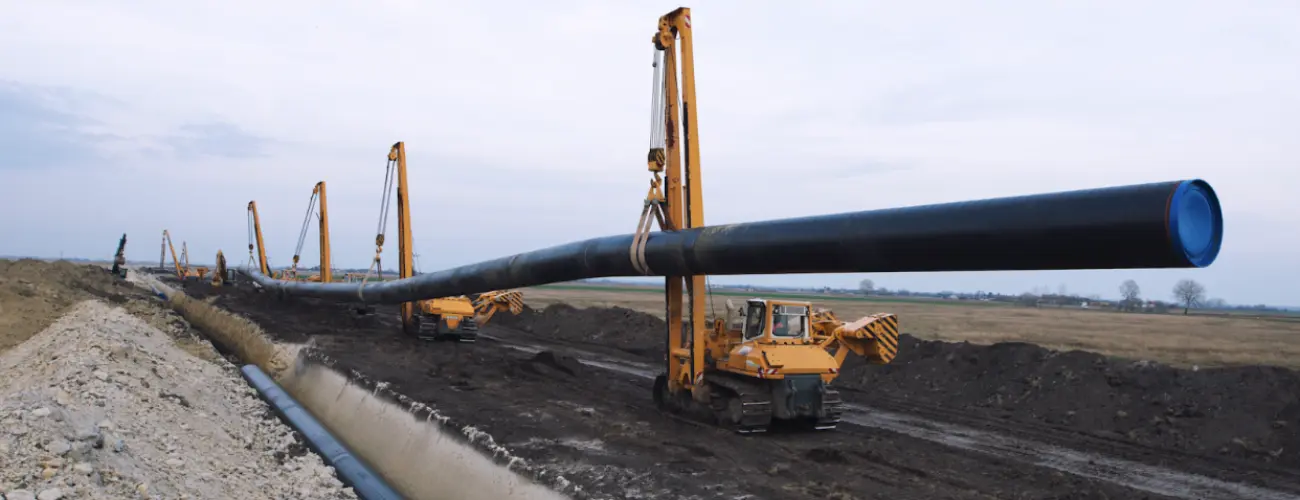The Benefits of Underground Work With Creek Pipe trenching services
The Relevance of Pipeline Construction: Checking Out the Solutions Offered in the Industry
Pipeline construction is a vital part of contemporary framework. It assists in the transportation of necessary sources like oil, gas, and water. The market incorporates various solutions, including planning, website preparation, and setup. Each stage requires accuracy and adherence to safety requirements. As communities depend on these systems for their livelihoods, comprehending the intricacies of pipeline construction discloses its importance and potential difficulties. What elements affect the success of these tasks?
Introduction of Pipeline Construction Services
Pipeline construction solutions encompass a series of customized activities designed to assist in the installment of pipes for carrying different materials, consisting of oil, gas, and water. These solutions usually include website preparation, excavation, setup of pipe sections, and backfilling. Competent labor and innovative devices are basic for guaranteeing each stage is performed with accuracy and safety.Safety procedures are vital, as these jobs often involve functioning with dangerous materials and in tough settings. Quality control actions establish that the pipes satisfy industry standards and guidelines. In addition, the solutions might involve trenchless technology, which reduces surface area disruption.Environmental considerations play a substantial duty in pipeline construction, requiring evaluations and reductions to shield bordering communities. On the whole, pipe construction solutions are vital for developing the infrastructure necessary for energy and water distribution, supporting both economic development and societal requirements.
Preparation and Layout in Pipeline Projects
Efficient planning and design are crucial components of effective pipeline tasks, ensuring that all facets are diligently dealt with prior to construction starts. This phase includes extensive usefulness researches that examine the technical, financial, and environmental aspects affecting the task. Designers and designers collaborate to create detailed strategies that describe the pipeline route, materials, and construction approaches, straightening with regulative requirements and market standards.Advanced software application and modeling strategies are typically used to mimic various scenarios, optimizing the style for performance and safety. Environmental effect analyses are performed to reduce potential harm to ecological communities and neighborhoods, reflecting a commitment to lasting techniques. Furthermore, stakeholder involvement is essential, cultivating interaction and addressing worries from affected parties. Inevitably, effective preparation and style established the foundation for a pipeline task, lessening risks and making certain a streamlined construction procedure, ultimately adding to the total success of the operation.
Website Preparation and Excavation
Thorough website preparation and excavation are important action in the pipe construction process. This phase entails a comprehensive analysis of the land where the pipe will certainly be mounted. Task groups perform studies to identify dirt types, topography, and existing energy lines to guarantee a risk-free and efficient excavation. Appropriate site preparation decreases environmental effect and promotes smoother construction operations.Excavation complies with, where hefty machinery is utilized to eliminate soil and rock, creating a trench that fulfills the defined deepness and width for the pipeline. This process should abide by safety regulations and environmental guidelines to stop damages to bordering ecosystems.Additionally, disintegration control actions are implemented to support the website throughout and after excavation. Reliable website prep work and excavation add significantly to the general success of pipeline tasks, laying a strong structure for the succeeding stages of construction.
Pipeline Installation Techniques
Pipeline installation strategies are necessary for the effective execution of infrastructure jobs. Two popular approaches include trenchless technology, which minimizes surface area disturbance, and the open-cut excavation procedure, known for its uncomplicated approach. Each strategy provides distinctive benefits and factors to consider relying on task demands and ecological aspects.
Trenchless Innovation Methods
While conventional methods of pipeline installment often entail substantial excavation, trenchless technology techniques offer a much more efficient and eco-friendly option. These cutting-edge strategies, such as horizontal directional drilling and pipe bursting, decrease surface area disruption by permitting the installment of pipelines without considerable excavating. This not only lowers the ecological impact yet likewise greatly minimizes labor and reconstruction costs. Trenchless approaches facilitate the setup of pipelines in metropolitan locations where traditional excavation would be unwise or destructive to existing framework. In addition, these techniques can fit different dirt kinds and problems, making them versatile remedies for pipe construction. Ultimately, trenchless innovation stands for a significant advancement in the pipeline industry, promoting sustainability and functional performance.

Open-Cut Excavation Refine
Open-cut excavation remains a fundamental method in pipe installment, defined by the direct excavation of a trench to lay pipes. This method entails getting rid of soil and other materials to create a trench of sufficient deepness and size, permitting the positioning of pipelines at the required quality. Open-cut excavation is frequently preferred for its cost-effectiveness and simplicity, particularly in locations with steady dirt problems. It can interfere with surface tasks and requires careful planning to take care of traffic and ecological influences. Precaution have to be applied to safeguard workers and close-by infrastructure during the excavation pipeline leak detection procedure. In general, while open-cut excavation may not appropriate for all terrains, it continues to be a commonly used technique in pipe construction.
Evaluating and Quality Guarantee
Examining and high quality assurance are essential parts in pipe construction, making certain that setups satisfy recognized safety and security criteria and performance needs. Different examination techniques and techniques are employed to analyze material high quality and adherence to regulatory compliance. This methodical approach assists identify prospective problems prior to they escalate, securing the honesty of the pipeline system.

Examination Techniques and Techniques
Inspection strategies and techniques are vital components in making sure the integrity and safety and security of pipeline construction. Numerous approaches, including aesthetic evaluations, ultrasonic screening, and radiographic exams, are employed to find defects and validate top quality. Visual examinations enable for the recognition of surface anomalies, while ultrasonic testing uses acoustic waves to evaluate wall density and find imperfections inside. Radiographic assessments entail X-rays or gamma rays to produce pictures of the pipeline's structure, exposing covert concerns. Additionally, pressure screening is conducted to examine the pipeline's stability under functional problems. These methods collectively add to a detailed understanding of the pipeline's condition, making it possible for prompt maintenance decisions and making sure compliance with market criteria. Effective examination is crucial for stopping failings and advertising lasting basics functional safety and security.
Safety And Security Requirements Conformity
Making certain conformity with safety requirements is extremely important in pipe construction, as it directly impacts the job's total top quality and dependability. Complying with well established laws and standards assurances that construction methods alleviate dangers connected with pipeline setup and procedure. Creek Pipe contact. Rigorous testing protocols, consisting of non-destructive testing and pressure analyses, are critical in validating that pipelines can withstand the functional anxieties they will run into. Quality guarantee steps are also crucial, as they develop a framework for regular monitoring and analysis throughout the construction procedure. By focusing on security requirements compliance, firms not only safeguard employees and the atmosphere but likewise improve the integrity of the pipeline, eventually resulting in lasting operational success and public count on the facilities
Material Quality Examination
Material quality analysis plays a substantial duty in the general honesty of pipe construction. This procedure involves extensive testing and quality guarantee steps to ensure that materials satisfy industry requirements and specifications. Different examinations, consisting of tensile strength, rust resistance, and weld honesty assessments, are conducted to determine any kind of possible weaknesses. An extensive evaluation not only ensures the performance of the pipe yet additionally enhances safety and security and resilience over its lifespan. Additionally, executing quality assurance methods aids mitigate threats associated with material failures, which can lead to costly repair work and environmental risks. By focusing on worldly top quality assessment, business can assure compliance with regulatory demands while promoting self-confidence amongst stakeholders in the integrity of their pipe systems.
Repair And Maintenance Solutions
Upkeep and repair work solutions play an essential function in the durability and performance of pipe systems. These solutions incorporate routine assessments, fixing, and corrective actions to address damage, leakages, and other issues that might emerge gradually. Skilled technicians utilize advanced technologies such as ultrasonic screening and clever pigging to keep an eye on pipe stability, guaranteeing that any kind of possible issues are identified early.Additionally, maintenance programs often consist of arranged safety nets designed to improve system integrity and decrease the possibility of unforeseen failures. Repair solutions might involve the substitute of damaged areas, sealing leakages, or utilizing trenchless modern technology for minimal disruption.
Environmental Compliance and Safety And Security Procedures
Pipeline systems not just call for continuous maintenance and fixing to operate effectively however additionally must abide by stringent environmental conformity and safety actions. These laws are crucial for reducing eco-friendly effect and ensuring public security. Companies in the pipe construction industry apply extensive environmental evaluations before task initiation, identifying possible dangers to wild animals and ecosystems.Furthermore, adherence to safety methods protects employees and surrounding areas. This consists of regular training on emergency situation feedback and spill avoidance techniques.To maintain compliance, sectors utilize monitoring modern technologies to discover leakages and various other anomalies in real-time. Environmental administration strategies are often established to lay out actions for resolving unexpected issues throughout construction.Ultimately, strict adherence to environmental compliance and precaution not just satisfies legal responsibilities however likewise promotes sustainable methods within the industry, promoting a balance in between infrastructure development and ecological stewardship.
Regularly Asked Inquiries
What Career Opportunities Are Available in Pipeline Construction?
Profession opportunities in pipeline construction include functions such as project managers, engineers, welders, and safety assessors. These placements call for varied skills, offering paths for development in an essential industry of infrastructure development and power circulation.

Just How Do Pipeline Projects Influence Resident Communities?
Pipeline projects greatly influence local communities by affecting financial growth, giving task chances, and enhancing facilities. They might additionally raise concerns regarding environmental impacts, land use, and possible disruptions to neighborhood cohesion and all-natural communities.
What Modern technology Is Used in Modern Pipeline Construction?
Modern pipeline construction makes use of sophisticated modern have a peek at these guys technologies such as GIS for mapping, drones for aerial studies, and automated welding systems to boost performance, safety and security, and precision, eventually facilitating the efficient transport of resources throughout numerous terrains. Creek Pipe pipeline construction.
Just How Are Pipeline Construction Costs Estimated?
Pipeline construction expenses are approximated through in-depth evaluations of materials, labor, devices, and governing needs. Factors like terrain, job dimension, and ecological factors to consider also considerably influence the overall spending plan and financial planning for construction.
What Are the Greatest Difficulties in Pipeline Construction Projects?
The greatest obstacles in pipe construction jobs consist of regulative conformity, ecological problems, logistical concerns, safeguarding financing, and taking care of labor shortages. Each factor can considerably influence timelines and budgets, making complex the total implementation of the task.